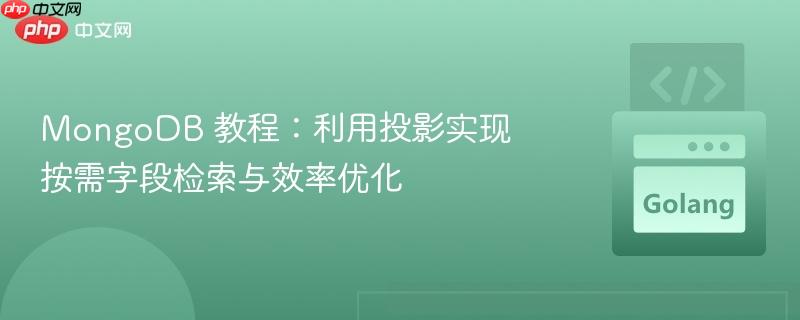
在 mongodb 中,当您从集合中查询文档时,通常会返回整个文档。然而,在许多场景下,我们只需要文档中的部分字段。为了满足这种需求,mongodb 提供了“投影”(projection)功能。投影允许您在查询结果中选择性地包含或排除文档的特定字段,从而减少网络传输的数据量,提高查询效率。
db.collection.find() 方法的第二个参数就是用于定义投影的。它接受一个文档,其中键是字段名,值可以是 1(表示包含该字段)或 0(表示排除该字段)。
假设我们有一个名为 mycollection 的集合,其中包含以下结构的文档:
{
"_id": 1234,
"parentfield1": {
"childfield1": { "data": "value1" },
"childfield2": { "data": "value2" },
"childfield5": { "data": "value5" }
}
}现在,我们希望根据输入的字段列表(例如 childfield1、childfield2、childfield3)来检索数据,即使 childfield3 在原始文档中可能不存在。
使用投影,我们可以这样实现:
db.mycollection.find(
{ "_id": 1234 },
{
"parentfield1.childfield1": 1,
"parentfield1.childfield2": 1,
"parentfield1.childfield3": 1 // 即使此字段不存在,也不会影响其他字段的返回
}
)执行上述查询后,如果文档 _id 为 1234 存在,且 parentfield1 中包含 childfield1 和 childfield2,则输出结果将是:
{
"_id": 1234,
"parentfield1": {
"childfield1": { "data": "value1" },
"childfield2": { "data": "value2" }
}
}关键点:
在实际应用中,您可能需要根据用户输入或其他业务逻辑动态地构建要检索的字段列表。这可以通过编程语言来实现。
以下是一个概念性的 Python 示例,演示如何动态构建投影对象:
import pymongo
# 假设您已连接到 MongoDB
# client = pymongo.MongoClient("mongodb://localhost:27017/")
# db = client.mydatabase
# collection = db.mycollection
# 假设这是您希望动态检索的子字段列表
desired_child_fields = ["childfield1", "childfield2", "childfield3", "childfieldN"]
# 构建投影字典
projection_dict = {}
# 默认包含 _id 字段,如果不需要可以设置为 0
# projection_dict["_id"] = 0
for field_name in desired_child_fields:
# 使用点表示法构建完整的字段路径
full_field_path = f"parentfield1.{field_name}"
projection_dict[full_field_path] = 1 # 1 表示包含此字段
print("动态构建的投影参数:", projection_dict)
# 使用构建好的投影参数执行查询
# result = collection.find({"_id": 1234}, projection_dict)
# for doc in result:
# print(doc)在 Go 语言中,您可以构建一个 bson.D 或 bson.M 对象作为投影参数:
package main
import (
"context"
"fmt"
"log"
"go.mongodb.org/mongo-driver/bson"
"go.mongodb.org/mongo-driver/mongo"
"go.mongodb.org/mongo-driver/mongo/options"
)
func main() {
// 假设您已连接到 MongoDB
// clientOptions := options.Client().ApplyURI("mongodb://localhost:27017")
// client, err := mongo.Connect(context.TODO(), clientOptions)
// if err != nil {
// log.Fatal(err)
// }
// defer client.Disconnect(context.TODO())
// collection := client.Database("mydatabase").Collection("mycollection")
desiredChildFields := []string{"childfield1", "childfield2", "childfield3", "childfieldN"}
// 构建投影 BSON 文档
projectionDoc := bson.D{}
// 默认包含 _id 字段,如果不需要可以设置为 0
// projectionDoc = append(projectionDoc, bson.E{Key: "_id", Value: 0})
for _, fieldName := range desiredChildFields {
fullFieldPath := fmt.Sprintf("parentfield1.%s", fieldName)
projectionDoc = append(projectionDoc, bson.E{Key: fullFieldPath, Value: 1}) // 1 表示包含此字段
}
fmt.Println("动态构建的投影参数:", projectionDoc)
// 使用构建好的投影参数执行查询
// var resultDoc bson.M
// err = collection.FindOne(context.TODO(), bson.M{"_id": 1234}, options.FindOne().SetProjection(projectionDoc)).Decode(&resultDoc)
// if err != nil {
// if err == mongo.ErrNoDocuments {
// fmt.Println("No document found with _id 1234")
// } else {
// log.Fatal(err)
// }
// } else {
// fmt.Println("查询结果:", resultDoc)
// }
}使用投影是 MongoDB 查询优化的一个重要方面,它带来了以下好处:
最佳实践:
通过熟练运用 MongoDB 的投影功能,您可以极大地提升数据检索的效率和灵活性,确保应用程序只获取所需的数据,从而优化整体性能。
以上就是MongoDB 教程:利用投影实现按需字段检索与效率优化的详细内容,更多请关注php中文网其它相关文章!

每个人都需要一台速度更快、更稳定的 PC。随着时间的推移,垃圾文件、旧注册表数据和不必要的后台进程会占用资源并降低性能。幸运的是,许多工具可以让 Windows 保持平稳运行。

Copyright 2014-2025 https://www.php.cn/ All Rights Reserved | php.cn | 湘ICP备2023035733号